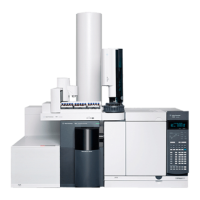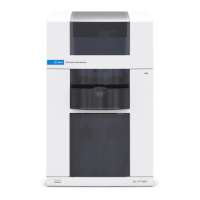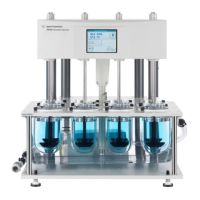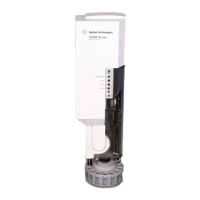Operating in Electron Impact (EI) Mode 3
Typical Vacuum Pressures in EI Mode
Operation Manual 51
Typical Vacuum Pressures in EI Mode
The largest influences on operating pressure in EI mode are the
carrier gas (column) and collision cell gas flows. Table 3 lists
typical pressures for various helium and nitrogen collision cell
gas flows. These pressures are approximate and will vary from
instrument to instrument by as much as 30%.
If the pressure is consistently higher than those listed, refer to
the online help in the MassHunter Workstation software for
information on troubleshooting air leaks and other vacuum
problems.
Table 3 Influence of carrier and collision cell gas flows on vacuum
CC Gas On
N2 = 1.5 mL/min
CC Gas Off
Column Flow
(mL/min) Rough Vac Quad Vac TOF Vac Rough Vac Quad Vac TOF Vac
0.5 1.16 * 10
-1
3.41 * 10
-5
4.20* 10
-7
8.29 * 10
-2
3.17 * 10
-7
2.15 * 10
-7
0.7 1.18 * 10
-1
3.41 * 10
-5
4.20 * 10
-7
8.67 * 10
-2
3.45 * 10
-7
2.15 * 10
-7
1 1.22 * 10
-1
3.43 * 10
-5
4.22 * 10
-7
9.17 * 10
-2
3.79 * 10
-7
2.16 * 10
-7
1.2 1.24 * 10
-1
3.43 * 10
-5
4.22 * 10
-7
9.49 * 10
-2
4.06 * 10
-7
2.16 * 10
-7
2 1.32 * 10
-1
3.44 * 10
-5
4.22 * 10
-7
1.07 * 10
-1
5.17 * 10
-7
2.17 * 10
-7
3 1.42 * 10
-1
3.44 * 10
-5
4.25 * 10
-7
1.19 * 10
-1
6.51 * 10
-7
2.20 * 10
-7
4 1.50 * 10
-1
3.46 * 10
-5
4.27 * 10
-7
1.29 * 10
-1
7.84 * 10
-7
2.21 * 10
-7

